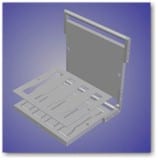CCSi UltraLife molds are designed, engineered, and manufactured to produce high quality specimens, over an extended service life!
CCSi manufactures these specimen molds for the determination of the impact resistance of plastic materials, as indicated in ASTM D256 ‘Standard Test Methods for Determining the Izod Pendulum Impact Resistance of Plastics’.
ASTM D256 consists of 4 procedures, A, C, D & E. Test Method B (Charpy Impact Test) has been removed from ASTM D256. It is being revised and will be introduced in a new standard, expected to be published 2004.
The 4 procedures described in ASTM D256 are summarized as follows:
- Method A: Cantilever Beam Test;
- Method C: Cantilever Beam Test for Materials of Less Than 27 J/m;
- Method D: Notch Radius Sensitivity Test;
- Method E: Cantilever Beam Reversed Notch Test.
The specimens described in each of these methods are of the same configuration, however dimension ‘E’ may vary. All specimens require notching, a device which CCSi supplies. Please visit the section on Buffers, Grinders, Nickers & Notchers for more information.
Ask for Price

CCSi UltraLife molds are manufactured from homogenous, solid, high carbon content A2 mold steel. Each undergoes precision grinding and CNC (Computer Numerical Control) machining to exacting requirements. The mold cavities are expertly honed and hand polished, after which the mold is industrial chrome plated.
Precision grinding ensures a parallel surface profile of the platens and CNC machining provides ultra-close dimensional tolerances, while the honing and polishing processes guarantee smooth, true specimen cavities. The durable, hard chrome finish resists the corrosive and adhesive effects of most compounds, greatly improving overall durability and ease of maintenance.
The CCSi UltraLife mold platens are thicker than standard molds, providing superior heat and pressure distribution, as well as extending the mold’s useful life by resisting distortion. This also allows the overflow recesses to be deeper, reducing problems associated overfill. The platens are positively positioned with precision guide pins and receivers … assuring precise closure!
CCSi UltraLife molds feature a unique cam-action hinge design which improves the critical distribution of pressure. Typical ‘fixed-hinge’ designs cause material to flow, outwardly, from this constraining point. This uneven application of pressure may cause excessive overfill, or cavity voids. The cam-action hinge design has all of the advantages of ‘stacked plate’ molds, combined with the convenience of ‘fixed-hinge’ designs!
The handles are manufactured from 304 stainless steel (a chromium – nickel austenitic alloy) and contain integral support pins. This allows the handles to rotate, which facilitates opening the mold. The handles are ergonomically positioned to ease placement and removal from the heated laboratory press.
Large triangular pry slots are located at the corners, opposite the cam-action hinges. These further facilitate mold opening and reduce the occurrence of cavity damage from improperly positioned tools.
The CCSi UltraLife TriPlate is a dual platen, center plate, configuration designed specifically for specimens which are typically die cut. The unique TriPlate design features a centrally positioned, ‘stacked’ plate located between two platens. The ‘sandwiched’ plate precisely mold-forms the specimen between the two hinged platens.
Die cut test specimens are often obtained from a test piece, or sample, which are first prepared in a laboratory ‘slab’ mold … a two step process. The UltraLife TriPlate design eliminates the need for first molding a ‘plaque’ and then die cutting a test specimen … saving valuable processing time!
An entire step in specimen preparation is removed, exponentially reducing introduced variables … as well as the costs associated with initial investment and maintenance of separate cutting dies and molds.
The CCSi ASTM D256 Specimen Molds Feature:
- Exclusive UltraLife engineering;
- Designed with advanced 3D solid modeling;
- Manufactured using computerized systems and techniques;
- CNC (Computer Numerical Control) 4 axis machining;
- Precision ground;
- Expertly honed;
- Finely polished;
- High carbon content A2 mold steel;
- Thicker plates resist warping, distribute heat and pressure evenly;
- Cam action hinges prevent uneven closure;
- Industrial chrome plate finish;
- 304 stainless steel rotating handles ease opening, closing and handling;
- Deep overflow recesses (flash pockets) reduce overfill problems;
- Precision locator pins & receivers assure positive alignment;
- High strength fasteners resist the effects of strain and stress;
- Temperature probe orifices may be added for profiling;
- Optional finishes are available for highly corrosive compounds.
Available in:
- UltraLife TriPlate design.
- ASTM D256 (Method A, C, D, & E).
Note: dimension E may be specified from between 3.0 and 12.7 mm (standard).
| Part Number | Mold Configuration | Specimen Dimensions (Refer to ASTM D256) |
| CCS-MD256-STD CCS-MD256-TRI | 5 Cavity | dual platen | 5 Cavity | TriPlate | Dimension A: 10.16 ± 0.05 mm (0.40 ± 0.002 inch) |
| CCS-MD256-STD CCS-MD256-TRI | 5 Cavity | dual platen | 5 Cavity | TriPlate | Dimension B: 31.80 ± 1.00 mm (1.25 ± 0.040 inch) |
| CCS-MD256-STD CCS-MD256-TRI | 5 Cavity | dual platen | 5 Cavity | TriPlate | Dimension C: 63.50 ± 2.00 mm (2.50 ± 0.080 inch) |
| CCS-MD256-STD CCS-MD256-TRI | 5 Cavity | dual platen | 5 Cavity | TriPlate | Dimension D: 0.25 R ± 0.05 mm (0.01 ± 0.002 inch) |
| CCS-MD256-STD CCS-MD256-TRI | 5 Cavity | dual platen | 5 Cavity | TriPlate | Dimension E: 12.70 ± 0.20 mm (0.50 ± 0.008 inch) |
specimen molds, molds, Standard Test Methods for Determining the Izod Pendulum Impact Resistance of Plastics, ASTM D256, D256, deformation, deflection, impact, izod impact, notch, notch sensitivity, notched specimen, reverse notch impact, notched bar impact test, notched bar, pendulum, pendulum impact, impact resistance, charpy.

